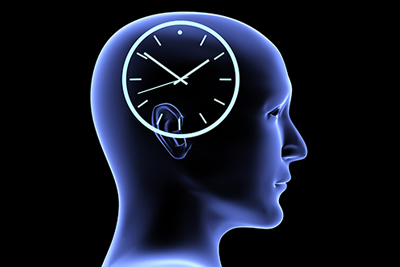Summer 2018
In a special laboratory, about 25 volunteers have each spent a month in a windowless, soundproof space, free from external time cues.
 They’ve lived on 28-hour cycles at Brigham and Women’s Hospital (BWH), with their eating and sleeping shifted four hours later every day, while researchers test their glucose, insulin, and other blood levels after controlled meals.
They’ve lived on 28-hour cycles at Brigham and Women’s Hospital (BWH), with their eating and sleeping shifted four hours later every day, while researchers test their glucose, insulin, and other blood levels after controlled meals.
The scientists conducting this multiyear study want to know how prolonged changes to circadian rhythms—the internal processes that follow a roughly 24-hour cycle—may affect metabolism and body weight in people who keep unconventional sleep-wake schedules, such as nurses, security guards, and pilots. “We know night shift workers are much more prone to gain weight and develop disorders like diabetes,” says study co-leader and BWH neuroscientist Jeanne Duffy, MBA, PhD, associate professor of medicine at Harvard Medical School.
In a nearby lab at Beth Israel Deaconess Medical Center, Clifford Saper, MD, PhD, James Jackson Putnam Professor of Neurology and Neuroscience at Harvard Medical School, is leading a related metabolism experiment to observe how mice adapt to a 20-hour schedule of light and darkness—four hours shorter than a normal day. Saper and Duffy are among some 60 faculty in the HMS Division of Sleep Medicinecontributing to the growing body of knowledge about sleep, circadian rhythms, and health.
Along with metabolism and sleep patterns, the circadian system influences many important functions, including heart rate, blood pressure, body temperature, hormone levels, and urine production. Circadian disruptions and lack

of sleep have been associated with serious health problems ranging from cancer to obesity to depression. Saper’s recent research also links circadian rhythms to aggressive behavior. “Circadian rhythms penetrate every aspect of life,” he says.
Found in most living organisms, circadian rhythms are regulated by light, behavior, and a biological clock mechanism—a set of clock genes located in cells throughout the body. Our master biological clock, based in the brain’s hypothalamus, is a cluster of about 20,000 nerve cells called the suprachiasmatic nucleus (because they sit above the optic chiasm). These cells get input from the eyes and send out signals about the time of day “so that all the body’s clocks run on a uniform schedule,” says Saper, whose team studies the brain circuitry involved in this complex process.
Even daily routines, such as reading our smartphones before bed, can interfere with our circadian rhythms. In recent studies, for example, Duffy and her HMS colleagues found that repeated evening use of a light-emitting tablet suppresses the release of the sleep-promoting hormone melatonin and shifts the circadian clock later, delaying bedtime and reducing alertness the next morning. Adjusting the brightness and color tones on e-devices may minimize these effects.
Our innate cycle is not exactly 24 hours, so our biological clocks must reset daily to sync with the Earth’s rotation. Because of this, and because each person’s light-dark exposure is different depending on habits and location, the timing of our biological clock is difficult to measure. “We’re trying to get to the point,” Duffy says, “where we can easily tell the biological time in your body, versus the biological time in mine.” In this way, circadian science holds promise for recommending health and behavior changes tailored to our individual makeup.
Debra Bradley Ruder is a freelance medical writer based in Greater Boston.
 The Harvard Mahoney Neuroscience Institute hosts a public lecture series to continue its efforts to educate the public on the latest scientific discoveries in neuroscience and translate how these discoveries are relevant in our daily lives.
The Harvard Mahoney Neuroscience Institute hosts a public lecture series to continue its efforts to educate the public on the latest scientific discoveries in neuroscience and translate how these discoveries are relevant in our daily lives.
 Since its founding in 1990, the Harvard Mahoney Neuroscience Institute has helped advance neuroscience at Harvard Medical School by promoting public awareness of the importance of brain research and by helping to fund research at the School’s Department of Neurobiology.
Since its founding in 1990, the Harvard Mahoney Neuroscience Institute has helped advance neuroscience at Harvard Medical School by promoting public awareness of the importance of brain research and by helping to fund research at the School’s Department of Neurobiology.